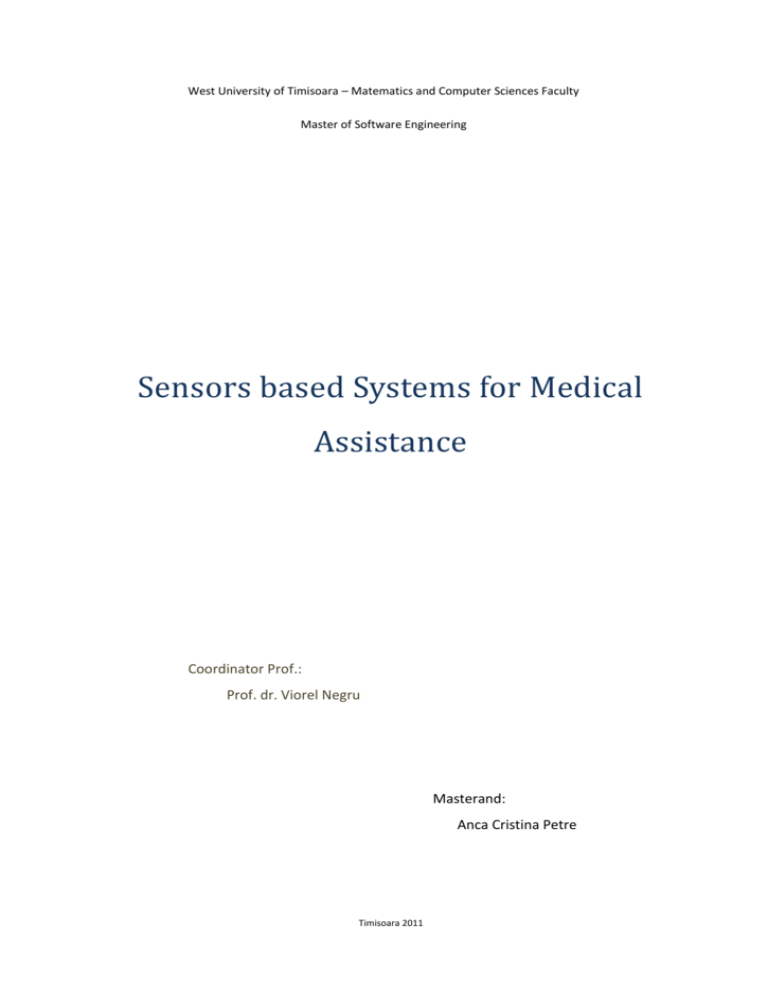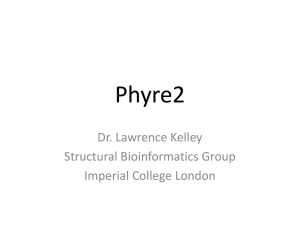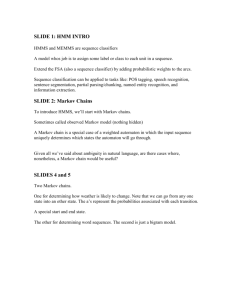draft dizertatie
advertisement

West University of Timisoara – Matematics and Computer Sciences Faculty Master of Software Engineering Sensors based Systems for Medical Assistance Coordinator Prof.: Prof. dr. Viorel Negru Masterand: Anca Cristina Petre Timisoara 2011 Table of Contents 1. State of work ................................................................................................................................... 3 2. Activity recognition ......................................................................................................................... 4 2.1. Introduction ............................................................................................................................. 4 2.2. Activity recognition approaches .............................................................................................. 6 Sensor-based, single-user activity recognition ................................................................ 6 Sensor-based, multi-user activity recognition .................................................................. 7 Vision-based activity recognition ........................................................................................ 7 2.3. Approaches of activity recognition ......................................................................................... 8 Activity recognition through logic and reasoning ............................................................. 8 Activity recognition through probabilistic reasoning ........................................................ 8 Wi-Fi-based activity recognition.......................................................................................... 9 Data mining based approach to activity recognition ........................................................ 9 2.4. Hidden Markov Models ......................................................................................................... 10 2.4.1. Theoretical background..................................................................................................... 10 2.4.2. Related work...................................................................................................................... 12 2.5. Asociation Rules .................................................................................................................... 12 2.6. Neural networks .................................................................................................................... 13 3. Activity ontology............................................................................................................................ 14 4. Software application ..................................................................................................................... 14 4.1. Form ...................................................................................................................................... 14 4.2. Prototype ............................................................................................................................... 14 5. Concluzions and further work ....................................................................................................... 14 6. Bibliography................................................................................................................................... 15 1. State of work Activity recognition has attracted increasing attention as a number of related research areas such as pervasive computing, intelligent environments and robotics converge on this critical issue. It is also driven by growing real-world application needs in such areas as ambient assisted living and security surveillance. This work .. 2. Activity recognition 2.1. Introduction With the advance and prevalence of low-cost low-power sensors, computing devices and wireless communication networks, pervasive computing has evolved from a vision to an achievable and deployable computing paradigm. As a result, research is now being conducted in all areas related to pervasive computing, raging from low-level data collection, to intermediate-level information processing, to high-level applications and service delivery. It is becoming increasingly evident that intelligent environments which can support both living and work places through flexible multimodal interactions, proactive service provision, and context aware personalized activity assistance will be commonplace in the very near future. For example, Smart Homes – augmented real or simulated home settings equipped with sensors, actuators and information processing systems, have been extensively studied. Work in this area has produced a number of lab-based or real-world Smart Home prototypes. Within a Smart Home the Activities of Daily Living of its inhabitants, usually elderly or disabled, can be monitored and analyzed so that personalized context aware assistive living can be provided. Activity recognition has emerged as a decisive research issue to the successful realization of intelligent pervasive environments. This relates to the fact that activities in a pervasive environment provide important contextual information and any intelligent behavior of such an environment must be relevant to the user’s context and ongoing activities. Activity recognition has been an active and fast growing research area. Whilst early work focused on the monitoring and analysis of visual information, such as images and surveillance videos, as a means to recognize activities, recent research has moved towards the use of multiple miniature dense sensors embedded within environments. These sensors are used to acquire the contextual data required for the process of activity recognition. Accordingly, a multitude of approaches and algorithms have been proposed and studied with the main differences between each being the manner in which the activities are modeled, represented, reasoned and used. Activity recognition aims to recognize the actions and goals of one or more agents from a series of observations on the agents' actions and the environmental conditions. Since the 1980s, this research field has captured the attention of several computer science communities due to its strength in providing personalized support for many different applications and its connection to many different fields of study such as medicine, humancomputer interaction, or sociology. To understand activity recognition better, consider the following scenario. An elderly man wakes up at dawn in his small studio apartment, where he stays alone. He lights the stove to make a pot of tea, switches on the toaster oven, and takes some bread and jelly from the cupboard. After taking his morning medication, a computer-generated voice gently reminds him to turn off the toaster. Later that day, his daughter accesses a secure website where she scans a check-list, which was created by a sensor network in her father's apartment. She finds that her father is eating normally, taking his medicine on schedule, and continuing to manage his daily life on his own. That information puts her mind at ease. Many different applications have been studied by researchers in activity recognition; examples include assisting the sick and disabled. For example, Pollack et al. show that by automatically monitoring human activities, home-based rehabilitation can be provided for people suffering from traumatic brain injuries. One can find applications ranging from security-related applications and logistics support to location-based services. Due to its many-faceted nature, different fields may refer to activity recognition as plan recognition, goal recognition, intent recognition, behavior recognition, location estimation and location-based services 2.2. Activity recognition approaches Activity recognition is the process whereby an actor’s behavior and his/her situated environment are monitored and analyzed to infer the undergoing activities. It comprises many different tasks, namely activity modeling, behavior and environment monitoring, data processing and pattern recognition. To perform activity recognition, it is therefore necessary to (1) create computational activity models in a way that allows software systems/agents to conduct reasoning and manipulation. (2) monitor and capture a user’s behavior along with the state change on the environment. (3) process perceived information through aggregation and fusion to generate a highlevel abstraction of context or situation. (4) Sensor-based, single-user activity recognition Sensor-based activity recognition integrates the emerging area of sensor networks with novel data mining and machine learning techniques to model a wide range of human activities.Mobile devices (e.g. smart phones) provide sufficient sensor data and calculation power to enable physical activity recognition to provide an estimation of the energy consumption during everyday life. Sensor-based activity recognition researchers believe that by empowering ubiquitous computers and sensors to monitor the behavior of agents (under consent), these computers will be better suited to act on our behalf. Levels of sensor-based activity recognition Sensor-based activity recognition is a challenging task due to the inherent noisy nature of the input. Thus, statistical modeling has been the main thrust in this direction in layers, where the recognition at several intermediate levels is conducted and connected. At the lowest level where the sensor data are collected, statistical learning concerns how to find the detailed locations of agents from the received signal data. At an intermediate level, statistical inference may be concerned about how to recognize individuals' activities from the inferred location sequences and environmental conditions at the lower levels. Furthermore, at the highest level a major concern is to find out the overall goal or subgoals of an agent from the activity sequences through a mixture of logical and statistical reasoning. Scientific conferences where activity recognition work from wearable and environmental often appears are ISWC and UbiComp. Sensor-based, multi-user activity recognition Recognizing activities for multiple users using on-body sensors first appeared in the work by ORL using active badge systems in the early 90's. Other sensor technology such as acceleration sensors were used for identifying group activity patterns during office scenarios Vision-based activity recognition It is a very important and challenging problem to track and understand the behavior of agents through videos taken by various cameras. The primary technique employed is computer vision. Vision-based activity recognition has found many applications such as human-computer interaction, user interface design, robot learning, and surveillance, among others. In vision-based activity recognition, a great deal of work has been done. Researchers have attempted a number of methods such as optical flow, Kalman filtering, hidden Markov models, etc., under different modalities such as single camera, stereo, and infrared. In addition, researchers have considered multiple aspects on this topic, including single pedestrian tracking, group tracking, and detecting dropped objects. Levels of vision-based activity recognition In vision-based activity recognition, the computational process is often divided into four steps, namely human detection, human tracking, human activity recognition and then a high-level activity evaluation. 2.3. Approaches of activity recognition Activity recognition through logic and reasoning Logic-based approaches keep track of all logically consistent explanations of the observed actions. Thus, all possible and consistent plans or goals must be considered. Kautz[6] provided a formal theory of plan recognition. He described plan recognition as a logical inference process of circumscription. All actions, plans are uniformly referred to as goals, and a recognizer's knowledge is represented by a set of first-order statements called event hierarchy encoded in first-order logic, which defines abstraction, decomposition and functional relationships between types of events. Kautz's general framework for plan recognition has an exponential time complexity in worst case, measured in the size of input hierarchy. Lesh and Etzioni went one step further and presented methods in scaling up goal recognition to scale up his work computationally. In contrast to Kautz's approach where the plan library is explicitly represented, Lesh and Etzioni's approach enables automatic plan-library construction from domain primitives. Furthermore, they introduced compact representations and efficient algorithms for goal recognition on large plan libraries. Inconsistent plans and goals are repeatedly pruned when new actions arrive. Besides, they also presented methods for adapting a goal recognizer to handle individual idiosyncratic behavior given a sample of an individual's recent behavior. Pollack described a direct argumentation model that can know about the relative strength of several kinds of arguments for belief and intention description. A serious problem of logic-based approaches is their inability or inherent infeasibility to represent uncertainty. They offer no mechanism for preferring one consistent approach to another and incapable of deciding whether one particular plan is more likely than another, as long as both of them can be consistent enough to explain the actions observed. There is also a lack of learning ability associated with logic based methods. Activity recognition through probabilistic reasoning Probability theory and statistical learning models are more recently applied in activity recognition to reason about actions, plans and goals. Plan recognition can be done as a process of reasoning under uncertainty, which is convincingly argued by Charniak and Goldman. They argued that any model that does not incorporate some theory of uncertainty reasoning cannot be adequate. In the literature, there have been several approaches which explicitly represent uncertainty in reasoning about an agent's plans and goals. Using sensor data as input, Hodges and Pollack designed machine learning-based systems for identifying individuals as they perform routine daily activities such as making coffee. Intel Research (Seattle) Lab and University of Washington at Seattle have done some important works on using sensors to detect human plans. Some of these works infer user transportation modes from readings of radio-frequency identifiers (RFID) and global positioning systems (GPS). Wi-Fi-based activity recognition When activity recognition is performed indoors and in cities using the widely available Wi-Fi signals and 802.11 access points, there is much noise and uncertainty. These uncertainties are modeled using a dynamic Bayesian network model by Yin et al.A multiple goal model that can reason about user's interleaving goals is presented by Chai and Yang, where adeterministic state transition model is applied. A better model that models the concurrent and interleaving activities in a probabilistic approach is proposed by Hu and Yang. A user action discovery model is presented by Yin et al.,where the Wi-Fi signals are segmented to produce possible actions. A fundamental problem in Wi-Fi-based activity recognition is to estimate the user locations. Two important issues are how to reduce the human labelling effort and how to cope with the changing signal profiles when the environment changes. Yin et al. dealt with the second issue by transferring the labelled knowledge between time periods. Chai and Yang proposed a hidden Markov model-based method to extend labelled knowledge by leveraging the unlabelled user traces. J. Pan et al propose to perform location estimation through online co-localization, and S. Pan et al proposed to apply multiview learning for migrating the labelled data to a new time period. Data mining based approach to activity recognition Different from traditional machine learning approaches, a novel approach based on data mining has been recently proposed by a research group led by Dr. Gu. In this approach, the problem of activity recognition is formulated as a pattern-based classification problem. They proposed a novel data mining approach based on discriminative patterns which describe significant changes between any two activity classes of data to recognize sequential, interleaved and concurrent activities in a unified solution. The advantages of such an approach are: Firstly, they provide a solution which recognizes sequential, interleaved and concurrent activities in a unified computation framework. Secondly, no training is required for interleaved and concurrent activities since these two activity models can be derived directly from the sequential activity model. Thirdly, their solution is more noise tolerant because mining the differences of classes will not include noise patterns provided the noise distribution is random among classes. The noise-tolerant feature is particularly important in sensorbased activity recognition. 2.4. Hidden Markov Models 2.4.1. Theoretical background A hidden Markov model (HMM) is a statistical Markov model in which the system being modeled is assumed to be a Markov process with unobserved (hidden) states. An HMM can be considered as the simplest dynamic Bayesian network. In a regular Markov model, the state is directly visible to the observer, and therefore the state transition probabilities are the only parameters. In a hidden Markov model, the state is not directly visible, but output, dependent on the state, is visible. Each state has a probability distribution over the possible output tokens. Therefore the sequence of tokens generated by an HMM gives some information about the sequence of states. Note that the adjective 'hidden' refers to the state sequence through which the model passes, not to the parameters of the model; even if the model parameters are known exactly, the model is still 'hidden'. Hidden Markov models are especially known for their application in temporal pattern recognition such as speech, handwriting, gesture recognition, part-of-speech tagging, musical score following, partial discharges and bioinformatics. A hidden Markov model can be considered a generalization of a mixture model where the hidden variables (or latent variables), which control the mixture component to be selected for each observation, are related through a Markov process rather than independent of each other. The Hidden Markov Model(HMM) is a powerful statistical tool for modeling generative sequences that can be characterised by an underlying process generating an observable sequence. HMMs have found application in many areas interested in signal processing, and in particular speech processing, but have also been applied with success to low level NLP tasks such as part-of-speech tagging, phrase chunking, and extracting target information from documents. Andrei Markov gave his name to the mathematical theory of Markov processes in the early twentieth century, but it was Baum and his colleagues that developed the theory of HMMs in the 1960s. Markov Processes Diagram 1 depicts an example of a Markov process. The model presented describes a simple model for a stock market index. The model has three states, Bull, Bear and Even, and three index observations up, down, unchanged. The model is a finite state automaton, with probabilistic transitions between states. Given a sequence of observations, example: up-down-down we can easily verify that the state sequence that produced those observations was: Bull-Bear-Bear, and the probability of the sequence is simply the product of the transitions, in this case 0.2 × 0.3 × 0.3. Figure 1: Markov process example Hidden Markov Models Diagram 2 shows an example of how the previous model can be extended into a HMM. The new model now allows all observation symbols to be emitted from each state with a finite probability. This change makes the model much more expressive and able to better represent our intuition, in this case, that a bull market would have both good days and bad days, but there would be more good ones. The key difference is that now if we have the observation sequence up-down-down then we cannot say exactly what state sequence produced these observations and thus the state sequence is ‘hidden’. We can however calculate the probability that the model produced the sequence, as well as which state sequence was most likely to have produced the observations. Figure 2: Hidden Markov model example 2.4.2. Related work 2.5. Asociation Rules 2.6. Neural networks 3. Activity ontology 4. Software application 4.1. Form 4.2. Prototype 5. Concluzions and further work 6. Bibliography [1]. Fahd Albinali, Nigel Davies and Adrian Friday, "Structural Learning of Activities from Sparse Datasets", University of Arizona, Tucson and Lancaster University, Lancaster [2]. Rim Helaoui, Mathias Niepert and Heiner Stuckenschmidt, "A Statistical-Relational Activity Recognition Framework for Ambient Assisted Living Systems" [3]. Niels Landwehr, Bernd Gutmann, Ingo Thon, "Relational Transformation-based Tagging for Human Activity Recognition", Department of Computer Science, Katholieke Universiteit Leuven, Belgium [4]. Dr. Luke L. Chen, Dr. Jit Biswas, "Activity Recognition in Smart Homes", Research Institute of Computer Science, University of Ulster, Institute for Infocomm Research (I2R), A*STAR, Singapore, 2009 [5]. Ben Companjen, "Classification methods for activity recognition" [6]. H. Kautz. "A formal theory of plan recognition", University of Rochester, 1987 [7]. Jie Yin, Xiaoyong Chai and Qiang Yang, "High-level Goal Recognition in a Wireless LAN". In Proceedings of the Nineteenth National Conference on Artificial Intelligence, San Jose, CA USA, July 2004





